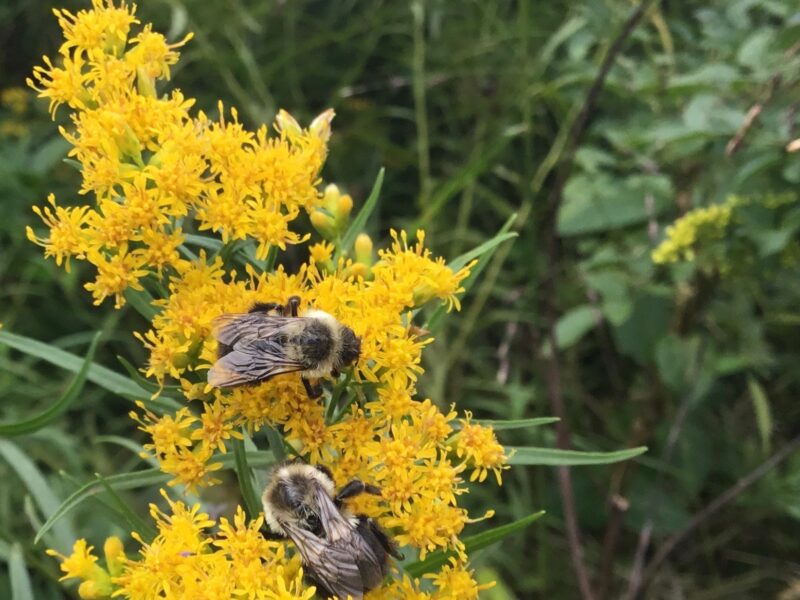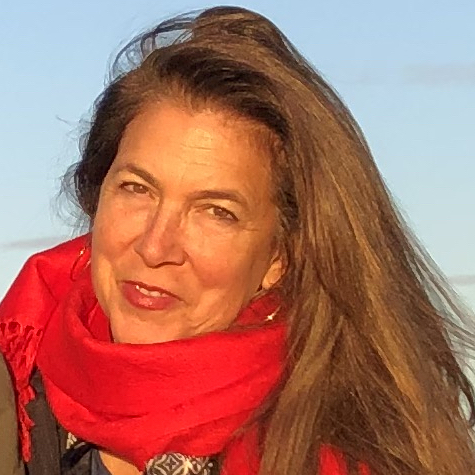

The Wainscott beach house that my ex-husband bought from his parents came with my mother-in-law’s white plastic daisies. Every weekend when we came out from the city, I would put them in a closet, only to return the following weekend to find them magically returned to the dining table. No matter what hinterland of closet, basement or outdoor trash can I hid them in, my mother-in-law, who lived just down the road, could always find them. This turf war went on for years — me too timid to confront her, but too stubborn to quit the game.
Why would anyone have ugly plastic daisies when we could have a garden full of fresh, pretty flowers?
Well. When you take a closer look at what many of the non-natives do to the environment, fresh flowers don’t seem quite so pretty after all. We pump them with chemical herbicides and pesticides that kill a whole web of wildlife. We load them up with nitrogen fertilizers that contaminate drinking water and pollute ponds, bays and the ocean, suffocating fish and pond life in general. They provide neither food source nor habitat for native insects, butterflies and birds. Not to mention the range of health issues using toxins in the yard causes for us.
While non-native flowers generally struggle without a lot of products applied to them, some adapt really well. So well in fact that they become invasive, crowding out the plants that belong here and support wildlife.
“Not only are they invasive,” master gardener Jay Hunt says, “But they get the birds to do their bidding, distributing seeds far and wide.”
When you think about all that non-native flowers do to our local ecosystem, it’s kind of ugly.
So what does a pretty flower look like? It should be from around here. Whether or not it’s technically “native,” an eco-friendly flower contributes a lot, and needs very little.
Flowers that are accustomed to Long Island are more resilient. They usually don’t need help with irrigation, fertilizer, insecticides, herbicides and attention from a lazy gardener.
Edwina von Gal of the PRFCT Earth Project summed up the difference this way: “Why would you plant a flower that’s whiny? You want one that’s delighted to be here because it’s evolved with this soil and climate.”
Flowers native to the East End offer a full buffet of tasty food for native insects, hummingbirds and butterflies. And if you like a pretty salad, they feed us locals as well. Hunt describes this symbiosis, “Like the way a panda bear has to eat bamboo. The local flowers attract local insects that attract local birds because they’ve grown up together. If they’re not used to the plant they won’t touch it.”
People talk about having “beneficial bugs” in the garden, but in reality most bugs are beneficial. Sparrows eat spiders. Warblers eat mosquitoes. Wasps pollinate flowers. Without bugs, birds have been going hungry. In the last 40 years, almost a third of the entire North American bird population has died. As Marders’ plant specialist Paige Patterson says, “Now we’re seeing a decline in birds we used to take for granted — screech owls, cardinals, Baltimore orioles, warblers and all kinds of songbirds. Even house sparrows.”
The environmentally friendly flower is also perennial. Annuals being pulled up and replanted year after year are like the single use water bottle of the plant world. From the fossil fuel used to power farming equipment to plastic containers they’re grown in, to the 18-wheeler refrigerated trucks shipping tropical flowers in from Florida, they generate massive amounts of greenhouse gases.
If we’re going to plant annuals, we might as well be planting plastic daisies. True, the Chinese factory my daisies were produced in probably had minimal environmental regulations, but at least they were a one shot deal. Had I kept them rather than buying fresh flowers year after year for decades on end, my floral carbon footprint would have been significantly less.
While in a perfect world, 70 percent of the yard should be native in order to maintain a healthy bird population, every little flower helps. Rather than ripping everything up willy nilly just because it’s not native and rushing out to the nursery, add native flowers one section at a time. Native plant enthusiast, Tim Purtell describes his garden on Shelter Island as a McDonald’s for beetles, butterflies, and 20 different species of bees. As one who moved toward planting natives over several years, he suggests starting with a 10-foot by 5-foot trial patch.
“Plant native flowers and see who shows up for lunch,” he advises. “If you like it, then keep expanding.”
A good rule of thumb is that if you haven’t walked on a certain section of your lawn within the past year, turn it over to flowers. Chances are, if you haven’t stepped foot on it in a year, you aren’t going to.
In the fall, the eco-friendly flower doesn’t need to be put to bed. Seed heads can be left on dried flowers as sustenance for migratory and song birds throughout the winter. Let flowers die back into the soil or go into compost rather than chucking them in a landfill, where they produce the intensely planet warming methane. Plus, it’s one less thing to do for the lazy gardener.
In the doldrums of winter when we’re craving pretty flowers, avoid cut flowers. Roses, for example, typically grown in Ecuadorian factories, are pumped so full of chemicals and preservatives, von Gal points out, “You wouldn’t want to put your nose in those things!” Not to mention the cargo ship emitting greenhouse gases getting them here.
Instead, consider drying summer flowers or opt for silk flowers. Like our friend the plastic daisy, silk flowers are an eco-friendly one time investment. These days, places like Marders sell beautiful imitations.
I asked local landscape designers and horticulturalists to pick five flowers that do it all: native, locally grown perennials, that feed everything (but the deer). Those that don’t need pesticides, herbicides, extra water or fertilizer. And of course, are pretty. The all-stars were mountain mint (not cat mint), asters (especially “October Skies”), bee balm, milkweed and goldenrod (especially “Firework”) which may look like ragweed, but doesn’t cause allergies.
Some of these wilder looking favorites didn’t seem like my idea of “cutting flowers.”
When I asked my florist friend about this, she pondered the question. “All flowers are cutting flowers if you like them.”
I had to start thinking beyond my own vase. Not just about what a flower could do for me, but what it could do for the bigger picture.
My mother-in-law has long since passed away, and now I kind of miss the white plastic daisies. If she were alive today, she’d be astounded by how our environment has changed — toxic algae blooms in Sag Pond, sunny day flooding in Montauk, massive homes creating noise and light pollution and the juicy scallops that once filled Peconic Bay now all but disappeared.
Let’s do ourselves and our environment a favor and grow flowers that do a lot more than just look pretty.
Resources:
Two Thirds for the Birds (234birds.org): Pretty and simply designed website with information about bird populations and how your garden can help feed and protect them. Includes a native plant database. Listen to footage of birds singing while you peruse.
Fort Pond Native Plants in Montauk: Wide selection of native flowers as well as the latest innovations in organic fertilizer and natural growth supplements. Alternately, encourage your local nursery to start a native plant section, if they don’t have one already.
Library Seed Exchange (most libraries): Reduce your native flowers’ carbon footprint by growing it from seed. Your local library should have a program to “borrow” seeds. Plant what you like and then at the end of the season, return your flowers’ seeds to the library.
Garden for Wildlife (gardenforwildlife.com): Great way to get started with variety packs of flowers native to New York, grown regionally and sustainably. Check out the Hummingbird Heroes and Monarch Munchable packages.
 More Posts from Jenny Noble
More Posts from Jenny Noble